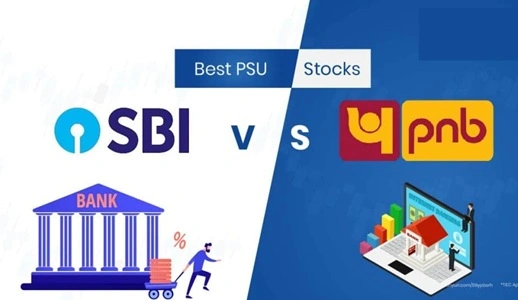With a market valuation of more than ₹7.28 lakh crore, State Bank of India (SBI) is the biggest bank in India. This is in contrast to Punjab National Bank (PNB), which is valued at ₹1.14 lakh crore. This significant discrepancy derives from SBI’s longtime position as the nation’s biggest public sector bank, which is supported by a vast network that comprises of 65,000 automated teller machines and more than 22,000 locations. PNB supervises more than 10,000 branches, with a concentrate on North and Central India, despite being the second-largest PSU bank in India following its merger with United Bank and Oriental Bank of Commerce. SBI’s share price, which is about ₹816, represents this institutional weight, while PNB’s share price, which is around ₹99.82, illustrates their differing investor opinions and market power.

Financial Resilience and Profitability Metrics
SBI has stronger financial stability than PNB, with a five-year compound annual growth rate (CAGR) of 19.90% compared to 9.42%. With a return on equity (ROE) of 28.8%, the former greatly beats PNB, which has mediocre profitability with net profit margins of 3.70%. These banks are further divided by their asset quality: SBI reported gross non-performing assets (NPAs) at 1.82%, a four-year low, while PNB, despite recent improvements, struggles with heavier historical stressed assets at around 4.13%. With the SBI share price displaying less volatility than its sector counterpart, this fundamental difference has a direct bearing on investor confidence.
Shareholder Returns and Dividend Profiles
Though SBI’s payments are substantially greater, both banks continue to maintain shareholder-friendly dividend policies. SBI paid out ₹13.70 in dividends per share in FY24, compared to ₹1.50 for PNB, which equates to yields of 1.68% and 1.44%, respectively. While PNB’s 30.74% one-year return demonstrates the probability of recovery from historically lower values, SBI’s 39.68% share price rise over the preceding year highlights its association with long-term wealth building. While contrarians hunt for turnaround potential in PNB’s lower share price, investors who value predictable income streams are enticed to SBI’s solid dividend history.
Risk Exposure and Valuation Considerations
Given that PNB is trading at a significant 43.16% discount to its 52-week high compared to SBI’s 11.76% deficit, its investment thesis is predicated on aggressive recovery forecasts. However, there are heightened operational risks associated with this apparent value advantage—PNB’s price-to-book (P/B) of 0.99 vs SBI’s 1.56. Due to PNB’s poorer capital adequacy ratios (17.01% compared to 14.25%) and contingent liabilities exceeding ₹6.93 lakh crore, caution is advised. As a result, the PNB share price reacts strongly to changes in the macroeconomic environment and challenges related to the resolution of non-performing assets (NPAs), whereas the SBI share price is protected from cyclical pressures by its stronger interest margins (2.33% vs. 2.59%) and diverse income sources.
Strategic Trajectories and Catalysts
The development of corporate loans and the implementation of digital banking are significant components of SBI’s growth strategy. The company’s recent diversification into wealth management and fintech partnerships has boosted the visibility of fee income. Citing intrinsic optionality in India’s formalization effort, experts expect a continual climb in the price of SBI shares. On the other hand, integrating merging firms and generating money from non-core activities to enhance capital buffers are crucial to PNB’s resurgence. If operational improvements are accomplished, government initiatives to address power sector non-performing assets (NPAs) would disproportionately favor PNB and speed the re-rating of its PNB share price. Monetary policy normalization puts both banks at risk of margin contraction, but SBI’s scalable infrastructure offers stronger resilience.
Concluding Assessment for Investors
For conservative portfolios, SBI is a “steady compounder” that delivers sustained growth underpinned by industry leadership and governmental backing. Return metrics and reducing borrowing costs tend to justify its higher value when compared to its PSU rivals. Despite an increasing return on equity (15.2% in FY25), PNB is still trading below book value, making it a plausible “recovery bet” for risk-tolerant investors. While the SBI share price reflects systemic stability, the PNB share price trajectory is still contingent on how successfully resolution steps are performed. The alternative ultimately comes down to investment horizons: PNB for speculative capital appreciation during reform-driven periods, and SBI for long-term asset preservation.